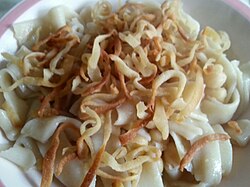Ciceri e tria: Difference between revisions
No edit summary |
mNo edit summary |
||
| Line 16: | Line 16: | ||
}} |
}} |
||
'''Ciceri e Tria''' {{IPA-it|ˈtʃiːtʃeri e |
'''Ciceri e Tria''' {{IPA-it|ˈtʃiːtʃeri e tˈtriːa|}} is a [[pasta]] dish in [[Italian cuisine]] that originated from Arabs who once ruled in [[Apulia]]. It is a part of the cuisine in the [[Salento]] region of Italy. It is prepared with pasta and [[chickpea]]s as primary ingredients, and includes fried pasta. The dish may be served as a ''primi piatti'' dish, a first course that consists of a pasta dish. It has been described as a "classic and emblematic dish of Salentine cuisine"{{sfn|Aggarwal|2013|pp=136–137}} and as a specialty dish of Apulia.{{sfn|Anderson|p=61}} |
||
==Origin== |
==Origin== |
||
Revision as of 14:25, 8 February 2016
 | |
| Type | Pasta |
|---|---|
| Place of origin | Italy |
| Region or state | Salento |
| Main ingredients | chickpeas and fried pasta |
Ciceri e Tria [ˈtʃiːtʃeri e tˈtriːa] is a pasta dish in Italian cuisine that originated from Arabs who once ruled in Apulia. It is a part of the cuisine in the Salento region of Italy. It is prepared with pasta and chickpeas as primary ingredients, and includes fried pasta. The dish may be served as a primi piatti dish, a first course that consists of a pasta dish. It has been described as a "classic and emblematic dish of Salentine cuisine"[1] and as a specialty dish of Apulia.[2]
Origin
In Apulia, the dish originated from Arab people who at one time ruled over the region.[3] Ciceri e Tria has also been stated to have originated in the Salento region of Italy (which is within the region of Apulia), where it is a common dish.[1]
Etymology
Ciceri means "chickpeas" in Latin.[4] Tria, meaning "pasta" or "noodle," derives from an Arabic word for pasta, إطرية iṭriyah (from the root طرو ṭ-r-w or طري ṭ-r-y 'to be fresh, moist, tender').[5] It means "pasta" in the Genoese dialect.[3][4] "Tria" can also refer to tagliatelle, a traditional pasta, the term being from the dialect of Apulia.[6] Tria can also refer to a type of pasta in Sicily.[7] Tria is an old word that is still used in many areas of Southern Italy, particularly in Sicily.[7]
Ingredients and preparation
Pasta and chickpeas are the primary ingredients in Ciceri e Tria.[1][4] Some versions of the dish may have a significant amount of broth, which may be eaten using a spoon.[1] Some of the pasta (from one-third to one-half) is fried in oil as part of its preparation, while the rest of it is boiled.[1][4] The use of fried pasta was originally performed to create a quality or mouthfeel of meatiness in the dish during times of meat scarcity.[1] The fried pasta may also add crunchiness to the dish.[1] Apulian versions may involve the chickpeas being simmered over a low heat while fresh pasta is being prepared.[4] Dried/uncooked chickpeas may be soaked one day prior to preparation of the dish.[4][3] Additional ingredients may include onion, carrot, celery and garlic.[4] It may be seasoned with black pepper.[4] It has been described as having a bacon-like flavor.[3] It may be served as a side dish with bread or rice.[1]
Service
In Apulia, the dish is a common primi piatti dish,[7] which is a first course of pasta. In the Italian formal meal structure, a first course is referred to as primo, and typically consists of hot food.
See also
References
Sources
- Aggarwal, Uma (2013). America's Favorite Recipes, Part II: The Melting Pot Cuisine. iUniverse. ISBN 1475977867.
{{cite book}}: Invalid|ref=harv(help) - Anderson, Burton. The Foods of Italy: An endless adventure in taste (5th ed.). Italian Trade Commission.
{{cite book}}: Invalid|ref=harv(help) - Gade, H. W. (2003). The Digital Pasta Book 1 / Italian pasta. Vol. 1. NORDISC Music & Text. ISBN 8788619478.
{{cite book}}: Invalid|ref=harv(help) - Taylor, John Martin (2013). The Fearless Frying Cookbook. Workman Publishing Company. ISBN 0761172009.
{{cite book}}: Invalid|ref=harv(help) - Zanini De Vita, Oretta (2009). Encyclopedia of Pasta. University of California Press. ISBN 0520944712.
{{cite book}}: Invalid|ref=harv(help)
Further reading
- Guaiti, Daniela (2010). Puglia (in Italian). Edizioni Gribaudo. p. 48. ISBN 8879068393.
